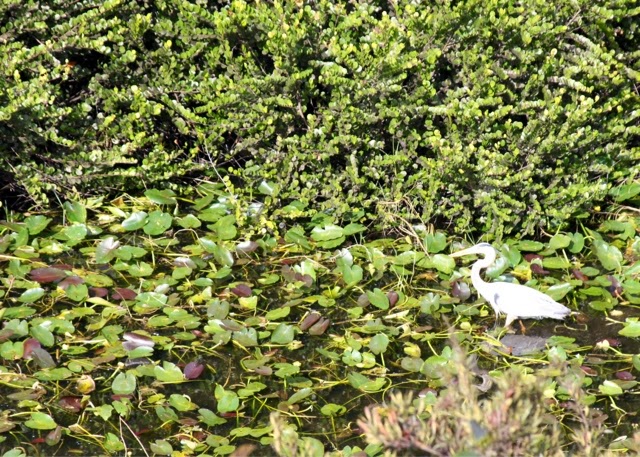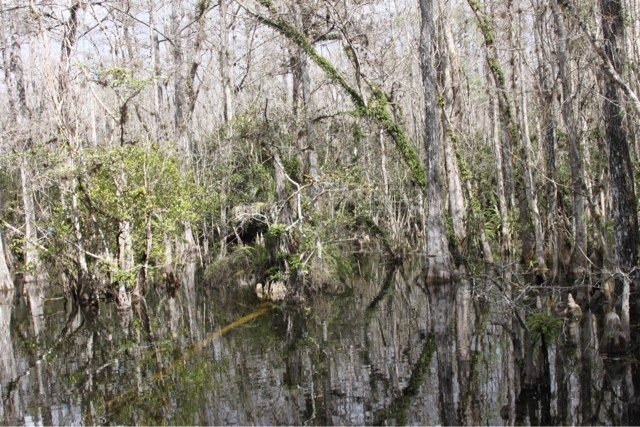Shark Valley
This is the tram we rode in at Shark Valley and yes, we saw over 100 alligators! I actually quit taking pictures of every gator I saw! The tram goes on a 15 mile loop through the park on a shared pathway with cyclists and walkers. Our tour guide called the people on bikes, "meals on wheels"!
Alligators
Wood Stork
See the scummy stuff on top of the water? It makes the water look polluted but it's not. It's algae known as periphyton and grows in mats among the watery everglades. These lumps shelter the base of the food web where the wildlife really begins!
Can you see the periphyton in this photo? In summer it's cigar-shaped; in winter, more like torn tissue paper.
Cypress Hammock; no, the cypress trees are not dead; they've lost their leaves. It's winter!
I like this picture because there are several different wading birds in the photo - wood stork, great blue heron, egret, and glossy ibis. Wow!
Another Wood Stork
Our tour guides were a husband and wife team - he drove, she talked. Before retirement she was a docent for the Philladelphia Zoo and very knowledgeable about the Everglades.
My first view of a Roseate Spoonbill. It was a long way off and just looked like a pink powderpuff!
Shark Valley Observation Tower
Scott headed towards the observation town at Shark Valley, below are the photos we took from the tower.
Me as I started back down the walkway. Scott had to get the wood storks in the background!
Night Heron drying its wings.
More Alligators!
Night Heron
Baby alligators - we saw baby alligators several times but they were hard to photograph because their mothers were nearby and very protective. This was when I decided I was glad I wasn't a cyclist!
Female Anhinga
Night Heron searching for fish.
Great Blue Heron
Little Blue Heron
Night Heron
Female Anhinga wearing her "tan cashmere sweater"!
Big Cypress Swamp
White Egret
I took this picture to show how clear the water is in Big Cypress Swamp. The branch and plants in this photo are 2 to 2 1/2 feet below the surface.
How many birds can you find?
Snowy Egrets are easy to identify by their bright yellow feet!
We are driving down a backroad when we see this big ol' guy. He was on Scott's side of the road so he pulled over so we could get out for a better view. Well, he pulled over right next to another alligator (on my side), so when I opened my door I scared it and it rushed into the water; which, in turn, scared me! I screamed - definitely got Scott's attention! I don't know who was more frightened - me or the alligator!
Cardinal Epiphyte
Flamingo
Only a couple of people from Eastern Oregon would laugh hysterically, turn around and take a photo of an elevation sign! 3 feet, really? Guess that's a mountainous pass in Florida!
Next sign along the way... Cypress trees grow on a hammock (elevated island) so the elevation is now 4 feet!
It's winter so the cypress trees are bare. I did find a branch with some greenery; must be kinda like our Tamarack (Mountain Larch).
Periphyton, a closer look.
American Crocodile, the first time I've seen one and it's easy to tell them from alligators. Their snouts are narrower, eye ridges higher (bony scutes on their backs too), and their teeth are much more visible. This crocodile has his mouth open to cool off!
Florida Holly
Red Mangrove, just look at that root system!
Manchineel or the Tree of Death, everything about this invasive plant is poisonous. The park system has removed it from all trails but keeps it in the canal area for education purposes. How can it be identified? All it's leaves point downward unlike all other trees in the Everglades.
Can you spot the little crocodile resting on the tree branch?
Coot Bay, a freshwater lake.
Scott on Coot Bay.
Royal Tern, waterway navigators watch this bird because he always faces into the wind.
I'm busy looking for dolphins but we haven't found any yet...
The Red Mangrove is also called the "walking tree" because these "legs" will walk right out into the canal and eventually completely block it. The government keeps them trimmed back so they can't take over!
Croc
Tri-colored Heron, the only way I can tell this heron from the little blue is his white chest and belly.
Crocodiles
Osprey feeding chicks in her nest.
Mahogany Tree
Pods on the Mahogany Tree.
Birds out on the sandbar in Florida Bay.
Would you like to name your own island? It's really very simple - first you must live on it for 6 months and then it's yours to name! Maybe you could build a tree house?
What a great place for an osprey nest! The fishing great but that green light - at night it blinks every 4 seconds! Could you sleep?
This is one of the dolphins that followed our boat --- finger not quick enough to get the dolphin's face! Next time I'll take a movie!
Furthest point south in contiguous United States, Cape Sable.
Brown Pelican
I wonder if those canoeists know these vultures are watching them?























































































Awesome post in your blog .. thanks for sharing wonderful ideas..
ReplyDeleteHotel Marble